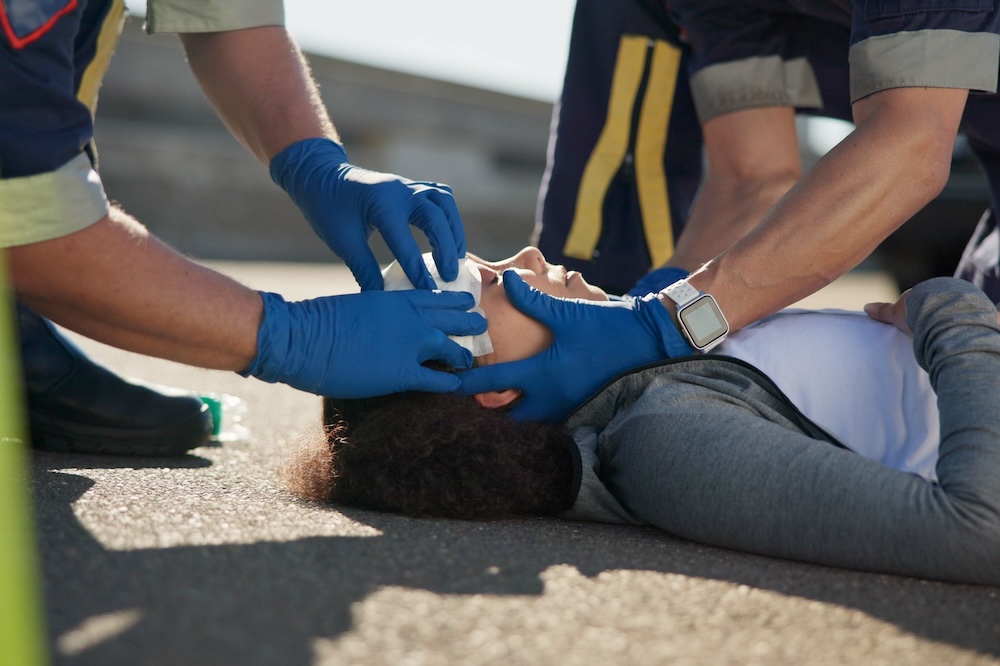For rural physicians, treating head trauma often means making important decisions without immediate access to advanced imaging. When a patient presents with a suspected brain injury and there’s no CT scanner available, clinicians rely on limited tools and clinical judgment to guide their next steps. In these situations, timely information can make a meaningful difference in how care is delivered, and in the outcomes that follow.
“People living in more remote communities are significantly more likely to experience a concussion than those based in cities, noting rural rates could be as high as 1,400 per 100,000 people.” – Brain Injury Canada
How Brain Bleeds Present in the Field
One of the most difficult aspects of managing head trauma in a rural setting is that symptoms don’t always show up right away, or they don’t tell the whole story. A patient might appear alert and conversational, able to answer questions and walk on their own. But that initial stability can be misleading. Bleeding inside the skull can progress silently, causing pressure to build over time until a sudden shift leads to confusion, unconsciousness, or worse.
Classic signs like headache, nausea, vomiting, or unequal pupils can be helpful, but they’re not always present in the early stages. And when they are, they often overlap with other conditions or injuries. In some cases, especially in elderly patients or those on blood thinners, deterioration can happen hours after the original trauma.
That’s what makes brain bleeds particularly challenging in the field. They often require clinicians to make a judgment call based on incomplete information. And that’s where having even a small window into what’s happening beneath the surface can be so valuable, because once symptoms become obvious, the damage may already be done.

What Rural Clinicians Are Up Against
In a rural setting, access to advanced imaging is often hours away, if it’s available at all. A helicopter flight or long ambulance ride might be the only option to reach a CT scanner, and that journey alone can be physically risky, emotionally stressful, and financially draining, for both patients and providers.
Clinicians often rely on their experience, intuition, and limited tools to make a judgment call. The Glasgow Coma Scale (GCS), pupil response, and neuro exams offer important clues, but they don’t always paint a full picture, especially in the early stages of a brain bleed. And that’s the critical challenge: a patient can appear stable at first, only to deteriorate quickly because of an undetected subdural or epidural hematoma.
Why Time Matters So Much
There’s a concept in trauma care called the “golden hour”, the first 60 minutes after a traumatic injury, where prompt intervention can significantly improve survival and long-term outcomes. With brain injuries, this window can be even narrower. Subdural and epidural hematomas can escalate quickly, compressing brain tissue and increasing intracranial pressure. Waiting too long to intervene often results in worse outcomes or, in some cases, outcomes that can no longer be reversed.
Studies have consistently shown that early detection and treatment of these bleeds is linked to reduced morbidity and mortality. The sooner a bleed is identified, the sooner a patient can be transferred for surgical intervention, or in some cases, managed safely on-site. But early detection has historically required access to a CT scanner, a barrier for many rural clinics.
A Smarter Way to Triage
This is where the right tools can really support better decision-making. Portable devices that use near-infrared light to check for bleeding under the skull are helping rural teams get answers faster. Instead of relying solely on observation or waiting hours for a scan, clinicians can assess a patient on the spot and get a clearer sense of what’s going on.
Consider a rural provider responding to a single-vehicle rollover. The driver is conscious but confused, with no visible head wound. The GCS score is borderline. In the past, the team might have monitored or transferred as a precaution. With a portable brain bleed detection device, they scan on scene and identify signs of a possible epidural hematoma. Transport is prioritized immediately, and the hospital is prepared before the patient even arrives.
In another case, an elderly patient in a rural clinic reports a fall two days earlier. She seems lucid but mentions a lingering headache and mild nausea. A scan reveals signs of a subdural hematoma that might have otherwise gone undetected until symptoms worsened. She’s transferred promptly for evaluation, avoiding a potentially dangerous delay.
In a remote school district, a high school athlete takes a hard hit during a game and reports dizziness. Instead of relying solely on observation or assuming it’s a mild concussion, the clinician uses a portable scanner to check for signs of internal bleeding. When no bleeding is detected, the provider can proceed with appropriate follow-up care without initiating an emergency transfer.
These tools aren’t meant to replace clinical judgment or CT imaging. They work alongside familiar triage methods, adding another layer of insight when it’s needed most. For many rural providers, that extra bit of clarity can be a game-changer: either confirming a gut instinct or catching something that might have gone unseen.
Where These Tools Fit in Rural Workflows
One of the key advantages of portable brain bleed detection tools is how easily they fit into existing clinical routines. They’re not meant to replace protocols or add extra steps, they’re designed to improve what’s already working.
Because they’re compact and require minimal setup, they can be used in a variety of care environments, from ambulances and emergency departments to community clinics and even long-term care homes. Many clinicians find they’re able to incorporate these scans into their routine assessments quickly and confidently.
The goal is to give providers more information without slowing them down.
Outcomes That Reflect Smarter Triage
When early detection becomes possible, everything downstream improves. Transfers become more purposeful: you send the patients who truly need urgent neurosurgical care, and you avoid sending those who can be managed locally. It reduces stress on families, preserves local healthcare resources, and keeps referral hospitals focused on the most critical cases.
Each avoided transfer means a patient stays closer to home, with a care team they know, avoiding the chaos and risk of long-distance trauma transport. And when a bleed is confirmed, escalation happens faster. The receiving hospital is prepped earlier. Transport can be prioritized. The patient gets into surgery sooner. In some cases, minutes saved in the field translate directly into brain function preserved.

Rural Care, Reimagined
No one understands their community’s needs better than local clinicians. But those same clinicians often work without the diagnostic infrastructure that their urban counterparts take for granted.
Providing tools that bring more certainty to high-stakes moments gives rural teams a way to see what’s happening inside the skull, without needing to move mountains or patients to do it, is a step toward more equitable care.
Timely, on-the-spot brain bleed detection helps level the playing field. It lets rural providers make sharper decisions under pressure, supported by evidence and insight.
The Road Ahead
Improving outcomes in rural trauma care is about closing critical gaps. When practical tools bring fast, reliable insight to the point of care, the path forward becomes clearer. Clinicians aren’t being asked to do more with fewer resources; they’re being equipped to do what they already do best, with greater confidence and accuracy.
The future of rural care will depend on solutions that respect the realities on the ground while raising the standard of what’s possible.
About ArcheOptix
ArcheOptix is a Canadian medical device company dedicated to transforming the way Traumatic Brain Injuries are assessed, delivering CT-level accuracy for rural communities, emergency response teams, sports medicine, and more. Our focus on innovation and clinical excellence drives everything we do.

